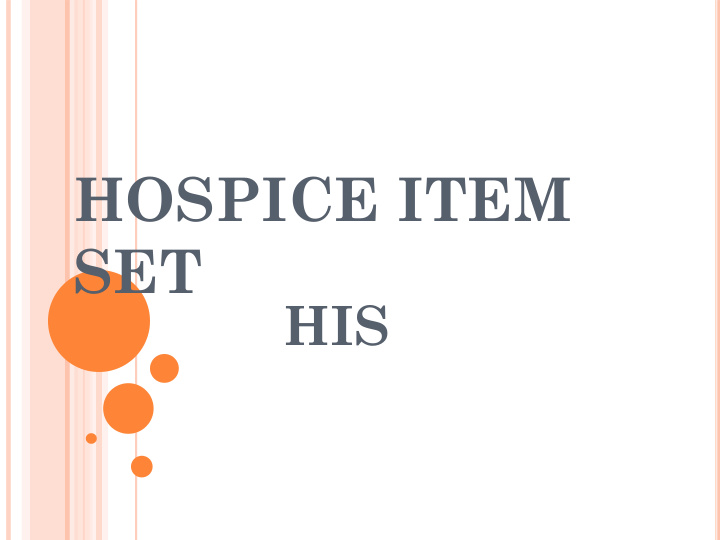



HOSPICE ITEM SET HIS
I NCORPORATING HIS INTO QAPI P ROGRAMS Track and trend patients’ palliative care and quality of care outcomes, not just on admission but throughout hospice care Results can be reported based on all teams as well as individual teams. Drill down further to team members Provide measurable patient outcomes that show strengths and PIP opportunities
P AIN AND D YSPNEA A SSESSMENTS Patients screened for pain and dyspnea during each nursing visit Was a standardized pain tool used? Was a comprehensive assessment performed?
T REATMENT FOR P AIN AND D YSPNEA Patients who c/o pain and dyspnea that receive treatment Were new medications and interventions added or adjusted?
R EASSESSMENT WITHIN 24 AND 48 HOURS Patients that receive a follow-up call or visit within 24 hours of a change in symptom management orders or interventions. Patients who receive symptom management for pain and dyspnea that achieve an acceptable level within 24 to 48 hours
B OWEL R EGIMEN WITH O PIOID U SE Patients who are treated with an opioid that are prescribed a bowel regimen or if not, a reason is documented EMR and Pharmacy reports can provide lists of patients who are prescribed opioids.
T REATMENT P REFERENCES Patients whose preferences regarding CPR, hospitalization, and life-sustaining treatments other than CPR were documented on the plan of care Patients whose documented preferences were not met or the reason for not following the preferences were documented in the medical record
H OSPICE -L EVEL Q UALITY M EASURE R EPORT View HIS data during a specific reporting period Compare your data to other providers Available as of December 2016 Log into QIES ASAP and retrieve from CASPER reports
R ESOURCES FOR THE HIS www.cms.gov www.nhpco.org www.ghpco.org
CAHPS
Caregiver perception of your organization’s performance Aggregate data related to specific areas of concern, ie: pain medication teaching Positive feedback Comparison of your organization to the national/state average for each data point
DRILL DOWN!
Is there a specific department that consistently has low scores? Is there a specific team member whose patients’ caregivers consistently report negative feedback? Is there a specific data point that is consistently lower than the benchmark? (ie: pain medication teaching) Set your goals at or above the state average
What other quality measures are there that can be compared against the CAHPS? HIS! Pain/dyspnea on admission-HIS VS. Pain/dyspnea symptom management-CAHPS
PIP – able to show a surveyor that you’ve identified an area for improvement and have come up with a plan Start a complaint/negative survey process for follow up by management This can also help drill down for negative trends in specific staff or departments EDUCATION, EDUCATION, EDUCATION! Staff don’t always know/understand what they’re being “judged” on
Lauren Ogilvie, PIS VITAS Healthcare 404-843-6533 Lauren.Ogilvie@vitas.com
The Program for Evaluating Payment Patterns Electronic Report PEPPER
Why PEPPER? • Medicare designated as high risk for fraud and abuse by Government Accountability Office (GAO) • Medicare Hospice Benefit identified as vulnerable • Office of Inspector General (OIG) encouraged hospices to audit to ensure charges are correct. PEPPER can help
What is PEPPER? • A single hospice’s claims data report – UB-04 claims submitted to Medicare Administrative Contractor (MAC) • Compares data to national, MAC jurisdiction, and state statistics • Centers for Medicare and Medicaid Services (CMS) contracted TMF Health Quality Institute to distribute
Who Gets PEPPER? • Provider only gets their report • TMF does not provide it to other contractors • TMF DOES provide Access database (First-look Analysis Tool for Hospital Outlier Monitoring (FATHOM) to MACs and Recovery Auditors – FATHOM can be used to produce a PEPPER
External PEPPER Request • CMS direction: – CMS can direct TMF to respond to external requests – Provided PEPPERS to OIG, DOJ, State Attorneys General • Department of Justice: – Uses billing data to create and corroborate investigative leads – Emerging fraud trends: • Medicare Part D Laboratory services • Drug diversion Hospital-based services • Hospice care
PEPPER Access • Compares 3 years of data • Identify trends reflecting possible fraud and waste – Priority areas to monitor/audit • Go to www.PEPPERresources.org – Available to CEO/Administrator and Compliance Officer
TARGET AREAS
Live Discharges • No Longer Terminally Ill – Review admission process – Meet eligibility criteria • Revocations – Initiated by patient – High cost care • Length of Stay (LOS) 61-179 days – Financial incentives
2014 LOS Data
Target Areas • Long LOS – Review admission process – Meet eligibility criteria
2014 LOS Data
Target Areas • Continuous Home Care in Assisted Living Facility – Meet eligibility criteria – Appropriate care in ALF – Documentation supports care hours billed
Routine Home Care IN: • Assisted Living Facility • Nursing Facility • Skilled Nursing Facility – Review admission process – Meet eligibility criteria
Target Areas • Single Diagnosis – Related to terminal illness – Substantiated with documentation – Physician determines • No General Inpatient or Continuous Home Care – Provide all levels of care – Process to assess needs
Next Steps • Review data – Are data differences due to your area • Identify priority areas to monitor/audit – Determine audit frequency – Develop improvement plan • Compliance Officer role – Stop issues before they become problems
Conclusion The Program for Evaluating Payment Patterns Electronic Report summarizes provider- specific data for Medicare services that may be at higher risk for improper Medicare payments. PEPPER can assist providers in identifying areas for improvement
References • Government Accountability Office. “Medicare Fraud, Waste and Abuse: Challenges and Strategies for Preventing Improper Payments.” June 15, 2012. Available at: http://www.gao.gov/new.items/d10844t.pdf . • Department of Health and Human Services/Office of Inspector General. 1999. “Publication of the OIG Compliance Program, Guidance for Hospices, “ Federal Register 64, no. 192, October 5, 1999, 54031-54049. Available at: https://oig.hhs.gov/authorities/doc/hospicx.pdf.
Recommend
More recommend